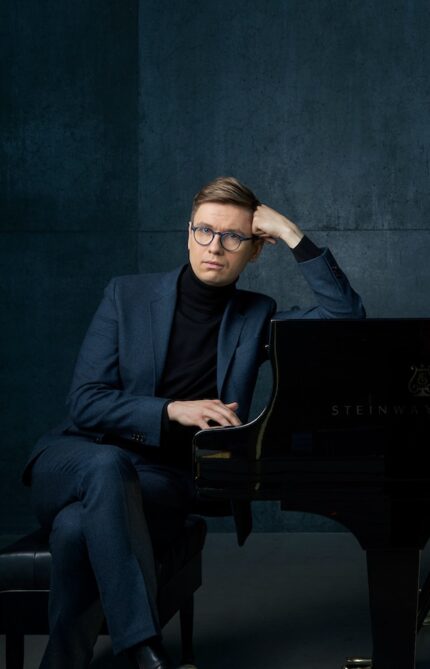Ólafsson brings fresh insight to late Mozart in sensational Chicago debut

“Don’t worry, I’m not going to do stand-up comedy,” said pianist Víkingur Ólafsson, as he walked out on the stage of Orchestra Hall Sunday, mic in hand, for his Chicago debut.
The Icelandic pianist, 38, has been making waves in recent years for his insightful performances across a wide array of repertory. His series of well-reviewed recordings on Deutsche Grammophon rove freely from Bach and Mozart to Debussy, Rameau, and Philip Glass.
For his Chicago program, Ólafsson performed music of Mozart and his contemporaries. The program exactly replicated his 2021 DG album of the same name—15 works played in the same order straight through, 84 minutes without an interval. Yet there was nothing contrived nor any suggestion of the new-release party in his vital and probing performances.
The bespectacled Ólafsson conveys a retro-cool New Age look—apt since the concert, like his recording, offered a new way of hearing familiar music. In his engaging introduction, the genial pianist talked about his long journey coming to terms with Mozart’s difficulties and mentioning that the program was about the same length as “a midsize Mahler symphony.”
Ólafsson laid out his brief for Mozart as “the first Romantic composer,” with the late works represented on the program being “denser, more chromatic and experimental” that anything previously heard.
Impressive as his recordings are, one was unprepared for the virtuosity, exuberance and insight of —’s playing in the flesh. His technique is remarkable with unruffled control at high speeds, which—along with his graded dynamics and 21st-century perspective—consistently illuminated repertoire often casually tossed off in the opening minutes of recital programs.
With nine of the 15 selections, Mozart was the dominant composer of the afternoon. The remaining six works provided a nice counterpoint to Mozart’s music, like walking around a sculpture to gain a fresh perspective.
Baldassare Galuppi was a big noise in his day but his music is now almost entirely forgotten. Ólafsson’s luminous advocacy of two attractive slow movements from Galuppi sonatas shows that the Italian composer may well be due for rediscovery.
More rewarding still were a pair of Cimarosa items, heard in Ólafsson’s subtly harmonized arrangements. The pianist brought stately introspection to the Sonata No. 51 in A minor and rapt, pearly-toned beauty to Sonata No. 42 in D minor.
Unlike the two Italians who Mozart never met, the other celebrated composers were great friends. C.P.E. Bach’s Rondo II in D minor is wholly characteristic with its crazed modulations and sudden bursts, all thrown off by Olafsson with dazzling prestidigitation.
Ólafsson invested Haydn’s familiar Sonata in B minor with an unfamiliar edge and aggression—hard angularity in the opening Allegro and propulsive bravura in the Presto finale.
All the Mozart works came from the final decade of the composer’s short life, and Ólafsson’s bold playing made a case for his quasi-revisionist view of Mozart as pioneering Romantic.
Yet there was still Rococo delicacy in the Rondo in F major, with the minor-key episodes deftly pointed. Ólafsson’s combination of the Fantasy in D minor with the Rondo in D major imbued the former with dramatic power and the latter with exhilarating vitality. In the Kleine Gigue in G major, Ólafsson’s layered voicings made the Bach inspiration manifest in Mozart’s brief contrapuntal homage.
Even the Piano Sonata in C major, K. 545 emerged notably alive and scintillating in Olafsson’s winning rendition.
The Piano Series audience is usually among the most respectful in the city but such was not the case Sunday. The unmuffled coughs grew as the unbroken program continued and were especially distracting during the Adagio from Mozart’s String Quintet in G minor (in Ólafsson’s own transcription). Even so, he still conveyed the movement’s essential bleak rumination.
The scrupulously curated program reached its summit with the final three Mozart works. Ólafsson’s forceful take on the Sonata in C minor, K.457, was authoritative on the grand scale, exploring the dark shadows yet finding elevated expression in the spacious Adagio.
In the ensuing Adagio in B minor, the pianist played with his head low over the keyboard, almost seeming to conjure the depths of the score’s unblinking tragedy from dark regions.
The darkness was dispelled with a beneficent finale—Liszt’s transcription of Ave verum corpus, which concluded an illuminating musical journey on a note of glowing serenity.
The well-deserved ovations eventually brought Olafsson back out for an encore. Nothing that it’s “almost impossible” to follow Ave verum corpus, Olafsson managed to do so with a typically discerning selection: the Andante from Bach’s Organ Sonata No. 4 (Stradal transcription), which ideally blended prayer-like peace with simple eloquence.
Let’s hope Chicago doesn’t have long to wait for a return visit from this immensely gifted artist.